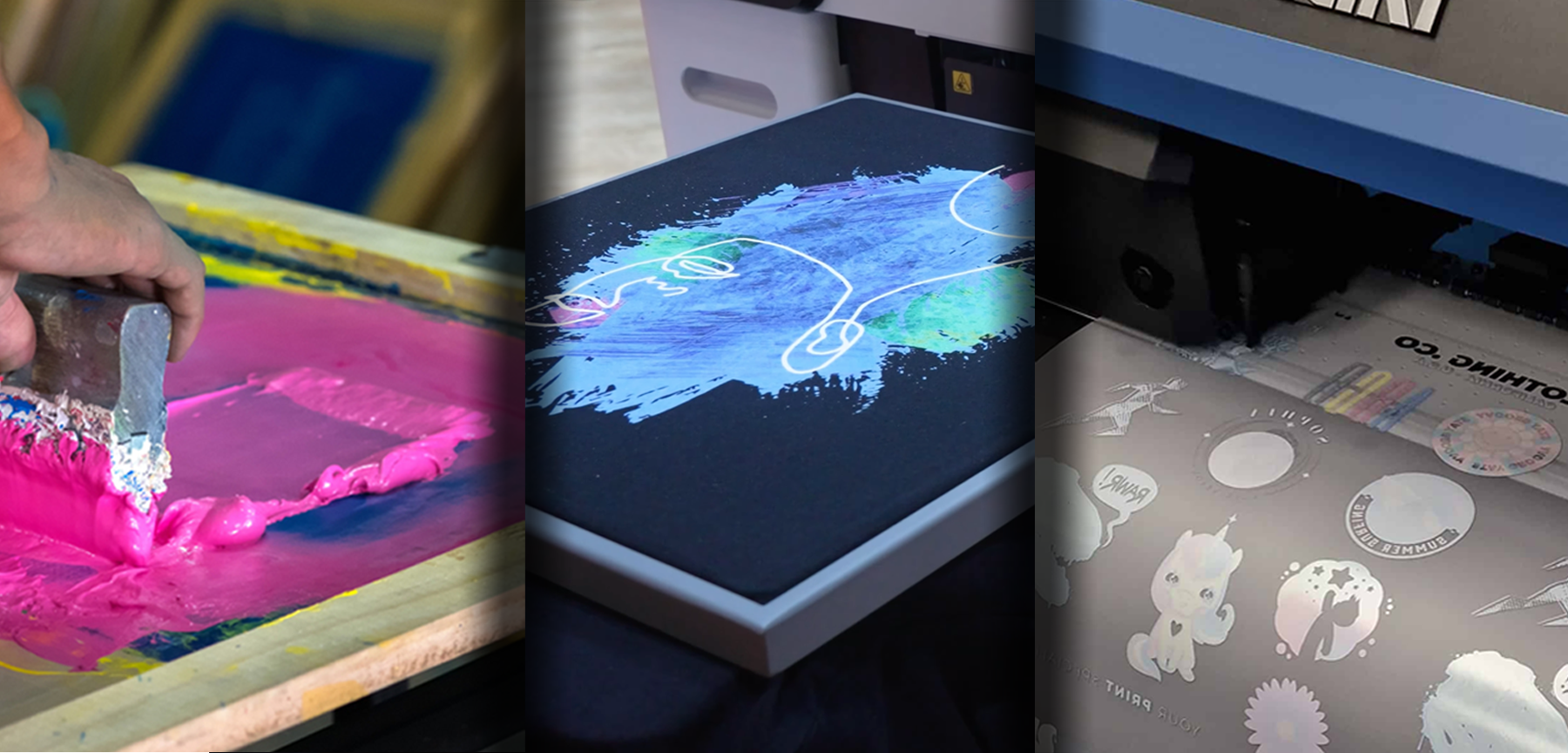
Custom Apparel Printing Techniques: From Screen Printing to Direct-to-Garment to Direct-to-Film
The world of custom apparel printing has boomed in recent years, giving rise to a vibrant marketplace for personalized clothing and accessories. But with so many printing techniques available, choosing the right one for your project can feel overwhelming. Three of the most popular methods - screen printing, direct-to-garment (DTG), and direct-to-film (DTF) - offer distinct advantages and considerations. Let's dive into the specifics of each technique to guide you toward the perfect printing solution for your needs.
Screen Printing: The Traditional Champion
 Screen printing stands as the tried-and-true method of custom apparel printing. It involves creating a stencil, or silkscreen, for each color in your design. Ink is then pushed through the stencil onto the garment, resulting in a crisp, opaque print with a raised texture.
Screen printing stands as the tried-and-true method of custom apparel printing. It involves creating a stencil, or silkscreen, for each color in your design. Ink is then pushed through the stencil onto the garment, resulting in a crisp, opaque print with a raised texture.
Screen printing shines in its ability to produce vibrant colors on a wide range of garment types and fabrics, including cotton, polyester, and blends. This method is particularly cost-effective for large orders, as the initial setup cost is spread across a higher volume of prints. Additionally, screen-printed designs offer excellent durability and can withstand frequent washing without significant fading.
However, screen printing has limitations. The setup process can be time-consuming and requires a separate screen for each color, making it less ideal for small orders or designs with complex color palettes. Additionally, intricate details may be difficult to achieve with screen printing due to the stencil's limitations.
Direct-to-Garment: A Digital Revolution
 DTG printing utilizes a modified inkjet technology to apply ink directly onto the garment. This method functions similarly to printing on paper, but with specialized inks designed to adhere to fabric fibers. DTG boasts exceptional detail and photographic image quality, making it ideal for complex designs with intricate details or gradients.
DTG printing utilizes a modified inkjet technology to apply ink directly onto the garment. This method functions similarly to printing on paper, but with specialized inks designed to adhere to fabric fibers. DTG boasts exceptional detail and photographic image quality, making it ideal for complex designs with intricate details or gradients.
The digital nature of DTG eliminates the need for screens, allowing for quicker turnaround times and greater design flexibility. This method also excels in small-order printing and print-on-demand services, as there's no additional setup cost per color. DTG inks produce a softer feel compared to screen printing, offering a more comfortable wearing experience.
However, DTG printing has its downsides. It's primarily limited to cotton or cotton-blend fabrics, and the ink may not achieve the same level of vibrancy as screen printing on darker-colored garments. Additionally, DTG prints may require specific care instructions to maintain their longevity.
Direct-to-Film: A Hybrid Contender
 DTF printing offers a unique blend of the benefits from screen printing and DTG. In this method, the design is first printed onto a special film using a modified inkjet printer. The design is then sent through a powder shaker and is cured by heat. Then, it’s applied to the garment with a heat press.
DTF printing offers a unique blend of the benefits from screen printing and DTG. In this method, the design is first printed onto a special film using a modified inkjet printer. The design is then sent through a powder shaker and is cured by heat. Then, it’s applied to the garment with a heat press.
DTF printing offers excellent detail and vibrant colors on a wider range of fabrics than DTG, including cotton, polyester, and blends. This method also boasts good washing durability and can be a good option for smaller orders with complex designs.
However, DTF is a relatively new technology, and the equipment and materials may be more expensive than screen printing or DTG. Additionally, the quality of the transfer can be highly dependent on the specific film and heat press settings used.
Choosing the Right Technique
So, which printing method reigns supreme? The answer truly depends on your specific project requirements. Consider these factors when making your decision:
- Order quantity: Screen printing is most cost-effective for larger orders, while DTG and DTG may be better suited for smaller batches.
- Design complexity: DTG and DTF excel at intricate designs, while screen printing is better for simpler graphics.
- Fabric type: Screen printing works well on various fabrics, while DTG is limited to cotton-based garments and DTF offers a wider range of compatibility.
- Turnaround time: DTG offers the fastest turnaround, while screen printing requires setup time per color.
- Budget: Screen printing is the most expensive upfront. Requiring screens, emulsion, ink, and a press. Costs increase with color complexity. DTG is less expensive upfront than screen printing needing a DTG printer, ink, pretreatment machine, and a heat press. DTF is generally less expensive upfront than screen printing (like DTG) needing a DTF printer, ink, film, transfer adhesive, powder shaker and dryer, and a heat press.
By understanding the strengths and limitations of each technique, you can make an informed decision and ensure your custom apparel project achieves the desired outcome. Remember, the perfect printing method awaits, ready to bring your creative vision to life!
No matter what your printing needs are, Millcraft offers DTG and DTF solutions to suit any project. Millcraft's expertise can help you navigate the different printer package options to find the right fit, so you can focus on what you do best – having a solution for your customers.
To learn more about our Apparel Solutions, Just ask.